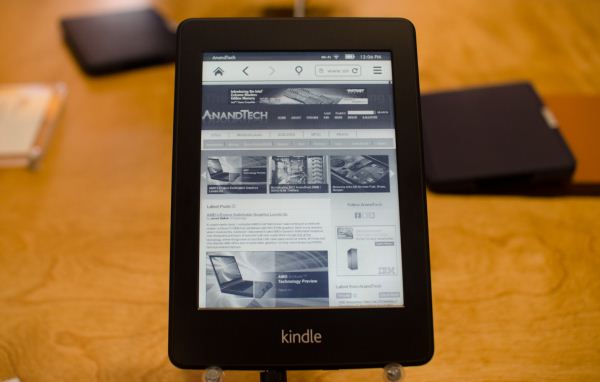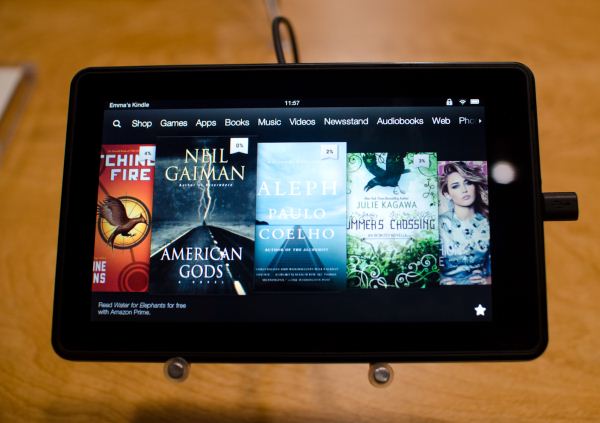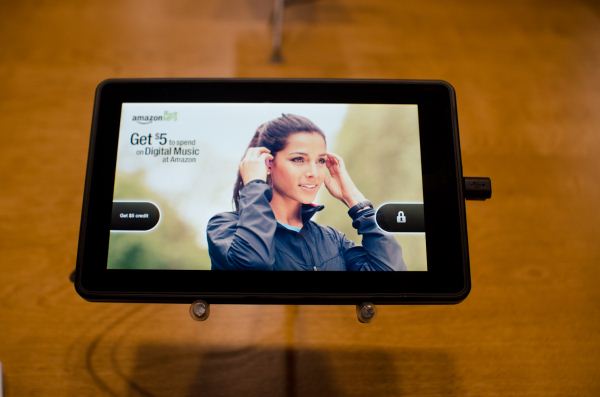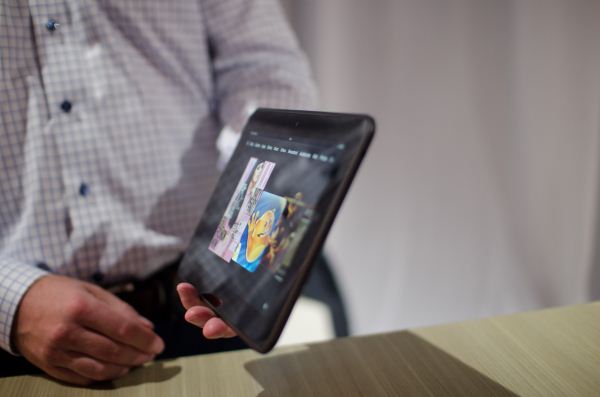
Original Link: https://www.anandtech.com/show/6246/amazon-kindle-preview-paperwhite-fire-2-and-fire-hd-7-89
Amazon Kindle Preview: Paperwhite, Fire (2012), and Fire HD 7" & 8.9"
by James Pikover on September 6, 2012 7:30 PM EST- Posted in
- iPad
- IPS
- Android
- ereaders
- Amazon
- Kindle Fire
- Kindle
- Kindle Touch
Earlier today Amazon revealed four new Kindle devices: a new Touch e-reader called the Kindle Paperwhite; the latest update to the Fire (not the Fire 2, just Kindle Fire); the Kindle Fire HD 7", and Kindle Fire HD 8.9". You can read the "liveblog" covering the event here.
Amazon's full-on assault against tablets and e-readers doesn't come as much of a surprise, but their announcements regarding actual hardware are interesting. Sure, everything's thinner, lighter, with a better battery and plenty of new software features. But all of the tablet devices are also running on TI's OMAP chips. In order, the Fire (2012) uses the 4430, Fire HD 7" has the 4460, and the 8.9" has the 4470.
Benchmarking was wholly restricted, so I was really limited with what I could do per device. Both of my Sunspider tests, which would have been skewed regardless due to really shoddy Wi-Fi plus Amazon's Silk browser (which runs a lot of the processing on the backend to produce faster results), were foiled by Amazon representatives. I spoke with Peter Larsen, VP of Kindle at Amazon, and he said they weren't allowing any benchmarks as of yet. So all preview notes are my own qualitative thoughts.
| Amazon Tablet Specification Comparison | ||||||
| Kindle Fire | Kindle Fire (2012) | Kindle Fire HD 7" | Kindle Fire HD 8.9" | |||
| Dimensions | 190 x 120 x 11.4mm | 189 x 120 x 11.5mm | 193 x 137 x 10.3mm | 240 X 164 X 8.8mm | ||
| Display | 7-inch 1024 x 600 IPS | 7-inch 1024 x 600 IPS | 7-inch 1280 x 800 IPS | 8.9-inch 1920 x 1200 IPS | ||
| Weight | 413g | 400g | 395g | 567g | ||
| Processor | 1GHZ TI OMAP 4430 (2 x Cortex A9) | 1.2GHz TI OMAP 4430 (2 x Cortex A9) | 1.2GHz TI OMAP 4460 (2 x Cortex A9) | 1.5GHz TI OMAP 4470 (2 x Cortex A9) | ||
| Memory | 512MB |
1GB |
1GB | 1GB | ||
| Wireless | Single-band Wi-Fi | Single-band Wi-Fi | Dual-band, dual antenna (2.4GHz, 5GHz, MIMO) | Dual-band, dual antenna (2.4GHz, 5GHz, MIMO) | ||
| Storage | 8GB (6.5GB usable) | 8GB (5.5 usable) | 16GB/32GB (12.6GB/26.9GB usable) | 16GB/32GB Wi-Fi, 32GB/64GB LTE | ||
| Battery | 16Whr | ? | ? | ? | ||
| Pricing | $199 (original price; no longer available) | $159 | $199/$249 |
$299/$369 - Wi-Fi |
||
A few tidbits regarding the latest Kindle Fire tablets (as well as the e-readers). They are all ad-based, utilizing the Special Offers program to help keep the prices down while displaying ads at lock screens and within certain apps. Unlike previous Kindle e-readers though, all upcoming Kindle devices will come with Special Offers built-in. You can't opt-out of the service, even if you plan on using the FreeTime kids application (though there are some barriers currently in place). This isn't necessarily a bad thing; it means interested buyers can get these tablets for low prices because of the ads, not in spite of them. And since they're not really intrusive, I'd be willing to sacrifice a lock screen for an ad.
All three of the Kindle Fire tablets include Special Offers, though the FreeTime application - essentially a kid's-zone where parents can set the duration and which apps, videos, and books kids can access- is unaffected by the Special Offers. I've reached out to Amazon regarding whether there is some sort of guideline for ads when FreeTime is enabled, but I was told definitively that apps taking advantage of Special Offers are fair game. Meaning if you have any app that works in FreeTime that also relays ads, your kids will see those ads, even if they aren't appropriate for kids. The only security there is children who have used up their alloted time will be locked out from viewing any ads...but only if the previously set time parents determine has up and passed.
Whispersync is also available across the entire Kindle family, allowing for books, voiced books, and games to have data saved across any device. Amazon hasn't announced any specific game system, like iOS' Game Center, though I wouldn't be surprised if some service for games sprouted up over the course of the next year.
Kindle Paperwhite
It may come as a surprise, but reading in the dark is actually something plenty of people would love to do. Leaving lights on to read is a hassle, wastes precious electricity, and isn't very easy on the eyes. The Barnes & Noble Nook Touch Glowlight addressed this, and it's a pretty good device, and now Amazon has a direct competitor to what many have called the one e-reader that's actually better than a Kindle.
The Paperwhite technology is interesting enough, though difficult to test in a moderately well-lit environment like a partially sunny airport hangar. The Kindle itself is noticeably faster than the last generation. It takes roughly 1-2 seconds for any new page to load completely, and 4-5 seconds over a moderate Wi-Fi connection for anything web-based.
You can check out the gallery above to see the differences in brightness using the Paperwhite technology. The brightness levels are relatively high, especially for an e-reader, though the whites are cold and I didn't find them particularly pleasing to the eye. That may prove different when actually reading in a dark environment, and adjusting the brightness accordingly.
| Amazon e-readerSpecification Comparison | ||||||
| Kindle Touch (2011) | Kindle | Kindle Paperwhite | Barnes & Noble Nook GlowLight | |||
| Dimensions | 172 x 120 x 10.1mm | 165.75 x 114.5 x 8.7mm | 169 x 117 x 9.1mm | 240 X 164 X 8.8mm | ||
| Display | 6-inch 600 x 800 16-level grayscale | 6-inch 600 x 800 16-level grayscale | 6-inch 1024 x 768, 16-level grayscale | 6-inch 600 x 800 16-level grayscale | ||
| Weight | 213g | 170g | 213g | 197g | ||
| Storage | 4GB (3GB usable) | 2GB (1.25GB usable) | 2GB (1.25GB usable) | 2GB (1GB usable) | ||
| Battery | Rated 2-months | Rated 1-month | Rated 8-weeks | Rated 1-month | ||
| Pricing | $79/$109 (original price; no longer available) | $69 | $119/$179 (3G) | $139 | ||
Both new Kindle e-readers (simply the Kindle and Kindle Paperwhite) are thinner than last year's Touch model, though the Paperwhite is identical in weight and is the true successor to the last generation. The Kindle stems from last year's non-touch e-reader, and is the lowest rung on the e-ink totem pole. At $70, it's also very affordable. I've owned several e-readers and while touch has always been convenient, tactile feedback is always welcome in my home. Interestingly, Amazon will continue selling the Kindle Keyboard 3G and isn't lowering the price or improving on the design whatsoever. Here is Andrew's review of last year's Kindle.
The Paperwhite, compared to last year's Touch, improves on size, shape, and reading in the dark, as well as the display density (from 167ppi to 212ppi), but drops 1.75GB of usable storage and raises the price significantly. For serious book readers, the drop from 3GB to 1.25GB doesn't mean very much; books are tiny and take up almost no space. But with the new Whispersync for Voice, it's presumable that a handful of voiced books will eat up the little drive space there is. Only the original Kindle e-reader had an SD card slot, but I'm waiting for Amazon to confirm that the latest models do not.
Kindle Fire (2012)
Like cars and, now, the iPad, Amazon is naming their latest Kindle Fire exactly that (just Kindle Fire), though this is definitely a second generation tablet. The differences are slim but noticeable; a slightly faster 1.2GHz clock speed, up from 1GHz, and double the RAM at 1GB. Users also get significantly less storage space, down to 5.5GB from 6.5GB, with no option to expand memory. The majority of changes made to the Fire aren't hardware-based though; it's in the software.
That said, current Fire owners - myself included - can expect some of the software upgrades to be implemented on last year's model, but Amazon is not revealing what updates will come to the 1st generation units. We'll have to wait until next week, when the new Fire releases, to see what changes are implemented to the original Fire, if they even release simultaneously.
I spent some time with the Fire, which was almost forgotten in lieu of the newer HD models. It's quite speedy, even considering the lower-end OMAP 4430 powering the device. While both the Fire HD units stuttered occasionally in demos, the Fire did not. It consistently ran smoothly, whether I started playing video, opened a magazine or app, or played in the web browser.
The sense I got from the newer Fire is that it's both meant to replace last year's model while simultaneously acting as a bridge for users skeptical about a tablet from Amazon. Or, for users who just want to watch Prime videos anywhere in their own home and don't need the upgraded display, additional horsepower, or thinner size. As the only Fire tablet not displaying video at HD quality, this model would best serve older people who want to watch, well, older videos available on Prime that don't have HD versions. The thicker build is certainly easier to grip two-handed, and it feels more stable than either of the HD models.
Yet because of the speed of the device, likely thanks to no HD visuals, anyone who won't nitpick about not having video and pictures HD-crisp may have a better experience with the lower-end and less expensive Kindle Fire than the Kindle Fire HD models. Even though they are more powerful devices, it's unclear if they have the increased bandwidth to offer the same speed and fluidity in everyday use that I experienced in ten minutes playing with the standard Fire.
Kindle Fire HD 7" and 8.9"
While Google and ASUS have been basking in the glory of the release of the Nexus 7, and with Apple expected to announce a smaller iPad as early as next week), Amazon has been busy building two devices that cover all bases, media and productivity.
The Fire HD 7" is a likable candidate in the race for best media tablet. The closed-OS mentality of Amazon's highly-modified version of Android may steer some users awry, but Prime users who enjoy the benefits of the thousands of TV shows and Movies that stream free through Fire tablets may have a greater interest in the closed OS. Amazon recently announced a partnership with Epix to add even more content to their service, which as of this writing includes a total of 2,037 TV seasons (1,524, plus 513 HD seasons) and 5,888 movies.
That is a lot, and Amazon has steered towards newer shows and films like The Avengers and Doctor Who, not I Love Lucy.
On top of that, Amazon's massive selection of books and magazines is the largest available, more than Apple and Google can muster for direct competitoin, and that likely won't change even if the Kindle tablets aren't successful. All of that considered, Amazon's focus for the HD tabs is twofold: more storage for a lower cost, and an excellent display. I'll need more testing to confirm the latter, but they've certainly made high-end tablets accessible by cost alone.
Again, without better equipment on-site and ample time to benchmark, I can't give any quantitative measurements on how good the display is. The way that Amazon is making the screens on both the 7" and 8.9" "stunning" is through laminating the two panes of glass together to get rid of any air gaps generally made between separate panes, and using what Amazon calls an Advanced True Wide polarizing filter, to improve viewing angles. The lamination is supposed to also reduce glare up to 25%, and from roughly ten minutes of use the glare is visibly less than typical tablets like the iPad or Galaxy Tab 10.1, but those observations were made under lamps, not sunlight.
Both screens are also very dense, at 254 ppi for the 8.9 and 215 ppi on the 7. On the one hand, I'm happy by the 1920 x 1200 resolution on the Fire HD 8.9", which utilizes the 16:10 aspect ratio instead of the more traditional 16:9 widescreen most of today's tablets, monitors, and TVs use. The additional vertical real estate will be beneficial for users who do a lot of web browsing and perhaps make use of productivity tools with the larger tablet. Then again, I know with the ASUS Transformer Prime Infinity TF700T, at 10.1" and with a display of 1080p, I don't need more space going down.The iPad, by comparison, has a 9.7" 2048 x 1536 4:3 display. The Fire HD 8.9 hits a pleasant median between not enough and too much pixel real estate. We'll have to see in further testing when the 8.9" releases in November.
I did play with the viewing angles, and as you can see in some of the pictures in the gallery above, the Fire HD seems to be viewable all around. I had no trouble reading at extremes of over 160 degrees.
The Fire HD models pre-load all non-streaming media (books, magazines) prior to viewing, which even under fast networks makes the tablets appear to lag. While waiting for the book/magazine to load, users still have full access to the device, but no loading screen and the darkened selected reading material just makes the whole process feel cheap, like it can't load properly. In fact, the Fire HD is loading the entire thing to the RAM so that flipping pages is as seamless as possible, which is a nice change of pace, especially for anyone who's used tablets like the Nexus 7 and notices how even on native magazines it takes a few moments to load every new page. Individual page loading doesn't occur on the Fire HD, at least not with the 7" model. The 8.9" model was kept away from public hands because it hasn't been certified by the FCC just yet.
One other point highly stressed by Amazon was the stereo speakers, which were impossible to hear in a crowded airport hangar. Stereo speakers aren't new to tablets; the Samsung Galaxy 10.1 2 has them in the front, directly facing users. On the Fire HD they are placed where users are expected to hold the device; cupping the hand over either of the speaker grills amplifies the sound forwards, though it isn't exactly comfortable to hold the Fire HD like that. I'll have to see how it feels in the home, under extended use.
Because there wasn't enough time to really play with the software, let's talk quickly about pricing for the 8.9" model. It comes in two forms, Wi-Fi only and LTE. The LTE model is, for now, US only, and works on AT&T's LTE network only. Sorry Verizon subscribers. The Wi-Fi version will sell (and is available for pre-order) for $300 and $370 for 16GB and 32GB, while the LTE model is $500 and $600 for 32GB and 64GB, respectively. If you, like roughly 95% of Americans, don't have AT&T LTE available in your area, the Fire HD does support HSDPA/HSPA+ (3G/4G) and EDGE (2G) networks, which is an improvement over Verizon's LTE network. AT&T's 4G network isn't nearly as stable, but it is nationwide in my experience.
For the first year, Fire HD 8.9: owners can pay $50 once for 250MB/month. After that year ends they go to a traditional data plan by AT&T. Monthly plans normally cost $15/month, totalling to $180, so the Kindle Fire HD 8.9" with LTE saves users $130 over other plans, not including the lower starting cost. Amazon also stated that the 3GB and 5GB plans will be available, but hasn't released pricing for those plans. Only the 8.9" tablet will have LTE available; the Fire HD 7" won't have that functionality whatsoever.
How about for international users? In the UK, France, Germany, Italy, and Spain the Kindle Fire HD 7" will be available on October 25th. The e-readers will be available sooner to over 100 countries.
The last note is on battery life. Amazon hasn't released any details on the batteries inside any of the Kindle devices, nor did so last year. In our review of the original Kindle Fire, the tablet used a 16Whr battery, which lasted 6 hours of continuous use. The Fire (2012) is expected to last, according to Amazon, 8.5 hours, while the Fire HD 7" should last 11 hours. There is no word yet on the Fire HD 8.9", but those numbers do fall in line with last year's numbers, the increase in performance power and RAM, and more efficient software.






















